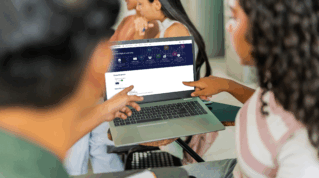There are some words these days that seem to have negative connotations attached to them despite being rather neutral in manner. Take ‘consequences’, for example. Many might look at this word and automatically assume something bad. Another example in in this category is ‘touch’.
If you hear about a person touching someone, your mind races to the many recent negative news stories on the topic, not least those related to the #MeToo movement. As a teacher, you immediately think of safeguarding concerns.
However, reading Touch Matters by Michael Bannisy, I was struck by the vast array of research that shows how effective touch can be in influencing behaviour and I believe it can be harnessed for good in the classroom.
In 1984, research in an American restaurant showed that when waiting staff touched a hand or shoulder when presenting the bill, they received higher tips than when no touch occurred. This has been followed by various studies in a variety of different places across the world that show a brief touch can influence how honest a person will be, how long they will stay in shops, how much alcohol they will drink and whether they will look after your dog.
One of the most interesting studies comes from Germany in 2021. It showed that even a touch from a robot can influence behaviour. Students were split into two groups to have a discussion with a humanoid robot. One group was touched by the robot three times and the other was not. When asked by the robot at the end whether they would join a particular course, 81 per cent of the students who were touched said yes compared with 59 per cent of those who weren’t. This is quite an incredible result and shows how humans crave connectivity and the crucial role touch plays.
It’s important to note that some students, notably those with sensory processing issues, will not respond positively to being touched. Teachers should be mindful, but as schools continue to struggle with pupil attendance, behaviour and mental health after the pandemic, there are four ways I think touch could help us in the classroom.
Meet and greet
In order to build relationships and to get a good start to the lesson, it’s often suggested that teachers should meet their students at the door. This is a good time to use the power of touch.
As you greet pupils, a touch on the shoulder or a fist-bump could make all the difference in getting them to settle down quickly and get on with the starter activity you have waiting for them. No need for extravagant welcomes like in the viral YouTube videos (but if you fancy it, give it a go!).
One primary classroom I’ve seen has a different student do the meet and greet each morning. This encourages pupils to connect with each other more. Better relationships between students will always enhance the learning environment.
Live marking
As you go around the classroom checking that students are getting on with their work and maybe even doing some live marking, a light touch can add meaning to a ‘well done’ or make that encouragement to keep going with a challenging task even more powerful.
Behaviour management
We’re all familiar with low-level disruption. Instead of calling it out from the front of the class and interrupting the flow of a lesson by calling it out, a subtle touch on the arm can let them know you’ve seen what they are doing and you want them to stop. This non-verbal request will often be very effective, and the research seems to suggest why.
Building relationships
Due to safeguarding concerns, there is now a fear of touch in school but a little prod on the arm to gee a student up for lesson or doing a comedy ruffle of the hair when a child has said something silly builds up a repartee between student and teacher, whether this is in the classroom, in form time or on the corridor.
Relationships are everything in teaching and it’s clear from the research that touch is a useful tool to build and sustain them. Will you give it a try? Let’s shake on it.











I work at a girls secondary school and I think it’s still best not to touch the students in any way short of providing first aid. While I understand some of the ideas in this article, there is so much scope for misinterpretation or accusation that it’s just not worth it.
The playful rustling of the hair was the verbatim example of what not to do in my safeguarding teacher training.
I for one don’t like being touched without my consent. A C word that is cruelly absent from this piece.
Having taught for 45 years I totally agree that relationship with pupils and indeed their family is essential.
The suggestions in the article are very perceptive and appropriate.
There are circumstances when pupils may also need to be comforted if they have had an upset in school or trauma such as a bereavement at home, illness of a loved one when pupils need to know you are there for them.An appropriate arm on their shoulders or hand gives them comfort. The key word is ‘appropriate’.
Teaching is a caring vocation not a career path to good salaries and a secure pension. It is about educating young people and making a difference for the better in their lives.
Particularly since Covid teachers don’t seem to want to touch books for marking let alone touch a young human being. Increasingly classwork and homework is set and completed online.
If the app fails the child fails.
This further discriminates against those less well off who can’t afford Internet or laptops for each child. It also disadvantages pupils in rural areas where Internet is poor.
It is a disconnect between pupils and teachers as many teachers use generic comment banks to fill in reports and there is little evidence to tell a parent,”This teacher knows my child personally and is interested in their well being and educational progression.”
Reports are increasingly sent out last day of the summer term.In my grandchild’s case a week into the holiday. They are emailed out. My daughter’s school app failed. School wouldn’t email or print a copy. We now have to wait until the technician returned from holidays in the middle if next month to get the app restored.
I agree AI has a positive role to play.
However it is no substitute for an interested and dedicated teacher. Covid has been a great excuse to disconnect us from each other and to take the opportunity to do less in the sphere of building relationships that draw us into wanting to do the best for our pupils and give children the best opportunities for future life. In my humble opinion,this needs to be addressed and reversed.
Nah! It’s not going to happen in this current climate when senior teams (and especially the current crop of sociopathic MAT leaders almost ALWAYS side with the children. Not worth risking your career for this.
This is really bad advice and could land people in serious trouble. Any touch is a risk and some people know this only too well.
In today’s world, the best thing any teacher can do is be in an entirely separate building, fully watched by cameras and other teachers and never interact with any student whatsoever outside of video conferencing the whole class.
You just can’t take the risk of false accusations that are immediately taken as gospel.
Fired without any investigation.
Your name, face and reputation destroyed before anyone even questions the validity of a child’s word.
Potential prison time without so much as a question asked of you other than “do you understand these rights as I’ve given them” by police.
Why anyone would get into teaching these days, is beyond me, glad I left and switched to engineering, much less hassle and I’m left alone to get on with my work.
No touching, full stop. It is open to misinterpretation.